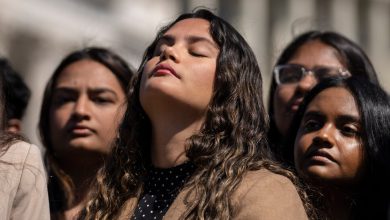Republicans Sense an Opportunity in Nevada’s Restless Latino Voters

When Senator Catherine Cortez Masto and her allies unveiled their first paid ads of the 2022 election cycle, the Nevada Democrat’s intended audience was clear: the state’s quarter-of-a-million Latino voters, a critical swing vote.
Majority Forward, the nonprofit arm of the Senate Democratic super PAC, has a Spanish-language ad called “Siga Protegiendo” — “Keep Protecting” — airing on Telemundo in Las Vegas. It hails Cortez Masto for her work as Nevada attorney general and in the Senate to “fight sex trafficking rings” and “protect our children.”
Another ad, titled “Led the Fight,” shows Cortez Masto speaking with Gladis Blanco, a Las Vegas hotel worker.
“When Covid first hit, there was a lot to worry about,” Blanco says as she wheels a cart of clean towels down a hallway. “My first priority was keeping my family safe, and I was very worried about making a living.”
“In times like that,” she added, “you want someone looking out for you. That’s what Catherine Cortez Masto did.”
It’s hardly the first time Nevada Democrats have made the Latino community a priority. In many ways, the state’s Latino voters are the backbone of the political machine built by Harry Reid, the Nevada senator and former majority leader who died in December. Nevada’s economy is powered by tourism, and the state’s powerful service-sector unions are closely intertwined with Latino politics.
Allies of Cortez Masto, the first Latina to serve in the U.S. Senate, also insist that it’s not usual to communicate this early in an election cycle with Latino voters. Their experience, they say, shows the importance of making persuasive arguments to the Hispanic community throughout a campaign — and not just toward the end.
A Guide to the 2022 Midterm Elections
- Midterms Begin: The Texas primaries officially opened the 2022 election season. See the full primary calendar.
- In the Senate: Democrats have a razor-thin margin that could be upended with a single loss. Here are the four incumbents most at risk.
- In the House: Republicans and Democrats are seeking to gain an edge through redistricting and gerrymandering, though this year’s map is poised to be surprisingly fair
- Governors’ Races: Georgia’s contest will be at the center of the political universe, but there are several important races across the country.
- Key Issues: Inflation, the pandemic, abortion and voting rights are expected to be among this election cycle’s defining topics.
“Nevada’s a state where you need a bilingual strategy,” said Arturo Vargas, the chief executive of the NALEO Educational Fund, a national civic engagement organization. He noted that service-industry workers had suffered heavily during the Great Recession, and again during the height of the coronavirus pandemic, when Las Vegas casinos were forced to shut down their operations. He said it made sense for Democrats to speak to their economic concerns.
But Republicans now sense an opportunity to peel away many of those votes, and in ways that could have national political reverberations. Some data in the latest Wall Street Journal poll suggest why. According to the poll, Republicans enjoy a 9-point advantage over Democrats in the so-called congressional generic ballot among Latino voters — meaning that, by a 9 percentage-point margin, respondents said they would prefer to elect a Republican to Congress.
There are reasons to be skeptical of these specific numbers: The poll sampled only 165 Latino voters, and the margin of error was plus or minus 7.6 percentage points. And Latino voters are hardly a monolith — the anti-socialism messages that have appealed to Cuban Americans in Florida differ widely from the jobs and health care-themed proposals that are effective with Mexican Americans elsewhere.
Plenty of other data suggests Democrats ought to be concerned, however. John Anzalone, a Democratic pollster who helped to conduct The Journal’s poll and a previous one in December, has called Hispanics “a swing vote that we’re going to have to fight for.”
Last year, a study by the Democratically-aligned firm Equis Labs found that Democrats had lost support among key Latino communities during the 2020 election. In 2020, exit-poll data showed that Donald Trump had made gains among Latino voters in Nevada specifically, even as he lost the state in that year’s presidential election. And more recently, our colleague, Jennifer Medina, reported that the shift toward Republicans among Latino voters in South Texas has continued.
“It’s not in question whether the Democrats are going to get a majority of the Hispanic vote in 2022 and 2024,” said Fernand R. Amandi, a managing partner of the Miami-based polling firm Bendixen and Amandi. “The problem for Democrats is they keep leaking oil against Republicans, and that is a trend that I think has been borne out over the last five years.”
Republican challenger seeks Latino vote
The bigger problem for Cortez Masto may be the low approval ratings of President Biden, which are dragging Democrats down with voters in general.
Public polls of the Senate race put her ahead of her likely opponent, Adam Laxalt, a former state attorney general and the scion of a Nevada political dynasty. But even in one January survey, showing Cortez Masto up 9 points over Laxalt in a head-to-head matchup, registered voters said they disapproved of Biden’s performance, 52 percent to 41 percent.
Last week, the Laxalt campaign — which has the backing of both Trump and Mitch McConnell, the Senate minority leader — launched “Latinos for Laxalt” in an effort to appeal to Hispanic voters. Cortez Masto’s allies have made sure to use Spanish-language criticism by Latinos against Laxalt — what they say is just smart, hard-nosed campaigning.
The Democratic Party in Nevada is also suffering from an unusual schism. In effect, the party has split in two between a group aligned with former allies of Reid, the late senator, and a smaller faction led by allies of Senator Bernie Sanders, the Vermont progressive.
The state’s top Democrats — including Cortez Masto, Senator Jacky Rosen and Gov. Steve Sisolak — are all working through a new entity called Nevada Democratic Victory, which is coordinating field operations and other statewide campaign spending with the Democratic National Committee in Washington.
It’s not completely clear what role the official Nevada State Democratic Party will play in the 2022 midterms. That group, which is led by Judith Whitmer, a Sanders ally, announced it had just half a million dollars on hand at the outset of the campaign season — money that it, nonetheless, said would be used to “mount a huge field campaign.” And while Cortez Masto’s allies insist that everything is running smoothly and that any tensions between the two groups have been ironed out, several also confess to having little idea of what the state party is doing.
The Cortez Masto campaign says it is taking no community in the state for granted, and is simply continuing the senator’s longstanding efforts to engage with an important constituency that was hit hard by the economic disruptions of the last few years.
“While Senator Cortez Masto continues to build on her strong record of fighting for the Latino community in Nevada, Adam Laxalt continues to show he can’t be trusted,” Josh Marcus-Blank, a spokesman for the Cortez Masto campaign, said in a statement.
Vargas, the head of the NALEO Educational Fund, said that mobilizing Latino voters, especially younger voters, will be a critical factor in November. His group has projected that turnout among Latinos will grow by 5.8 percent in Nevada during the 2022 midterms, but he declined to speculate as to which party might benefit.
“In the past, we’ve seen Latino voters express greater support for some candidates at the national level, but then it plummeted with other candidates,” he said. “The most recent election did suggest that, but it takes more than one election to determine a trend.”
What to read
-
President Biden said the United States would strip Russia of normal trade relations, joining the European Union and other allies in doing so, Ana Swanson reports. Keep up with our live coverage of Russia’s invasion of Ukraine.
-
A well-timed congressional endorsement by Nikki Haley in her home state of South Carolina created some distance from Donald Trump, even as she was embracing him at the same time. Jonathan Weisman reports.
-
The Democratic National Committee is expected to work on the sequence of presidential primary states. Astead W. Herndon reports.
viewfinder
Layers of history
On Politics regularly features work by Times photographers. Michael A. McCoy captured the photo above on Tuesday, as Senator Cory Booker met with Judge Ketanji Brown Jackson, Biden’s Supreme Court nominee, in his office. Here’s what McCoy told us about capturing that moment:
I was amazed by his book collection (and his Star Wars collection). One book was called Picturing Frederick Douglass, who was the most photographed person in the 19th century. I moved to the right side of Booker’s office, and once I was there, I saw how Jackson and Booker were speaking next to that photograph of Frederick Douglass. There were so many layers on top of layers in that photo. If it weren’t for Frederick Douglass, there would be no Cory Booker, Ketanji Brown Jackson, Mike McCoy, or anyone else of color who works in politics. My body, my soul — that picture just caught me.
Thanks for reading. We’ll see you on Monday.
— Blake & Leah
Is there anything you think we’re missing? Anything you want to see more of? We’d love to hear from you. Email us at [email protected].





